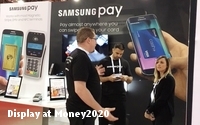Commentary
Mobile Payments Finally Catch a Break
- by Chuck Martin , Staff Writer, October 27, 2015
 After all these years, mobile payments
may be getting its long-awaited break in market adoption.
After all these years, mobile payments
may be getting its long-awaited break in market adoption.
This isn’t because all of a sudden mobile payments improved or that millions of consumers happened to feel the need to use their mobile phone to pay for things.
But rather, it’s a series of multiple things coincidentally happening all around the same time.
A few data points this week point to an increase in mobile payments.
From a research viewpoint, eMarketer’s latest projections have mobile payments growing from $9 billion this year to $27 billion next year. Individual consumer payment totals will grow from $376 a year to $721.
Another data point is that as more people acquire iPhones with Apple Pay capabilities, more people overall are using their iPhones to pay.
And there’s Samsung, which, after acquiring Boston-based LoopPay, got to include the Loop technology into its latest phones, which launched in the U.S. late last month.
Samsung this week said it is seeing high repeat usage of its Samsung Pay with an average of eight transactions per person.
The key to Samsung Pay is that it works at pretty much any point-of-sales terminal that can take a traditional card swipe.
I dropped by the large Samsung Pay booth at the annual Money2020 conference in Las Vegas yesterday and the company had multiple payment terminals set up so attendees could personally try Samsung Pay.
The conference itself is yet another indirect data point. The event drew 10,500 attendees this year along with a convention-sized hall full of exhibitors, most sporting technologies or services to help mobile payments along.
There were companies offering all kinds of mobile payment security features, such as fingerprint readers embedded in credit cards that work only via NFC and various other security capabilities.
Just about anyone who is anyone in mobile payments was a sponsoring company as well as presenter on the program and attendee interest was high again this year.
I see the potential biggest push for mobile payments in the U.S. coming from the increased usage of EMV or chip cards, now that the EMV deadline has passed. This essentially means that any merchant not using technology that can read the chip cards at checkout is liable for any of the credit card fraud that may occur.
But that’s just what is driving the adoption of chip cards. The mobile payments driver is how the cards actually work.
Rather than a quick swipe, the chip card is inserted into a reader where the chip is read, which I have written about here in the past (Mobile Payments vs. the New Chip Credit Cards).
The issue is the waiting.
For shoppers at checkout in a big box retailer this holiday season, this could become an absolute nightmare for the retailer.
In addition to normal volume-caused long checkout lines, the additional wait time for the chip card to be read could create a new, major pain point.
The great irony for mobile payments, which can be done by just a tap of the phone, is that they could become the best solution to a major pain point that never existed.



